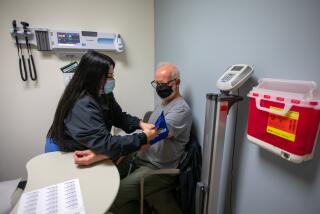DOCTORS AND PATIENCE
While reading the review of “A Whole New Life,” by Richard Selzer (May 22), I was drawn into his candor and understanding of the pain and suffering of a cancer patient, given that he is a surgeon. My own experience with medical doctors is that often the opposite is true.
I do have a problem, however, with Selzer’s statement regarding Price’s anger toward his radiation oncologist, who he stated had “all the visible concern of a steel-cheese-grater.” Selzer is quick to defend the doctor as a healer and compares the lack of bedside manner to the quirky personalities of great artists such as Beethoven. I found this to be an insult to those who rely upon the doctor for comfort when perhaps there is little left in the way of hope. Is it too much for a dying or suffering person to wish for a few kind words during the worst moments of their life? Should we accept from these individuals, who, by the way get paid much more than the artists he mentions, to be compassionate individuals. Healing is more than merely giving a prescription for chemotherapy or radiation, and doctors who lose their feelings of compassion are in my opinion burnt out and in need of a change of career.
DEBORAH ROSEN, COTO DE CAZA
*
Richard Selzer defends the behavior of a physician by explaining that withholding pity and compassion can be necessary for some doctors, especially those working with terminally ill patients. I do not take issue with this. It is not until the reviewer goes on to compare the behavior of doctors to that of “great artists,” many of whom have been “angry,” “misanthropic” and “condescending,” that I find fault with his argument. There is a major difference between artists and doctors, a difference which should be obvious to the reviewer, who is himself a doctor. Artists work with art, doctors work with people, and while it is no great sin for an artist to be misanthropic, for a doctor to hate mankind is a grave affront to the Hippocratic oath. Although I have no doubt that healing can be found in great works of art, it is not, nor has it ever been, the responsibility of artists to heal. Maybe it is time to remind Dr. Selzer of the line in his oath which states “and above all do no harm” and for him to take stock to the harm his attitude may be causing.
AIMEE E. PRICE, TORRANCE
More to Read
Sign up for our Book Club newsletter
Get the latest news, events and more from the Los Angeles Times Book Club, and help us get L.A. reading and talking.
You may occasionally receive promotional content from the Los Angeles Times.






